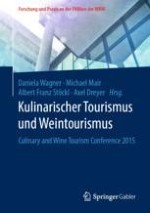2017 | OriginalPaper | Buchkapitel
10. Die kulinarische Attraktivität des Reiselandes Österreich: Selbstbild vs. Aussensicht/Austria’s Image as a Culinary Tourism Destination: Selfimage versus Outside Perspective
verfasst von : Claudia Bauer-Krösbacher, Albert Franz Stöckl, Stephanie Tischler
Erschienen in: Kulinarischer Tourismus und Weintourismus
Verlag: Springer Fachmedien Wiesbaden
Aktivieren Sie unsere intelligente Suche, um passende Fachinhalte oder Patente zu finden.
Wählen Sie Textabschnitte aus um mit Künstlicher Intelligenz passenden Patente zu finden. powered by
Markieren Sie Textabschnitte, um KI-gestützt weitere passende Inhalte zu finden. powered by
